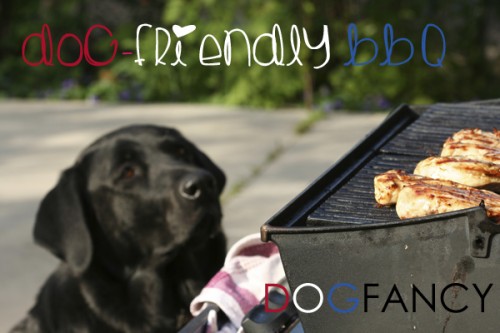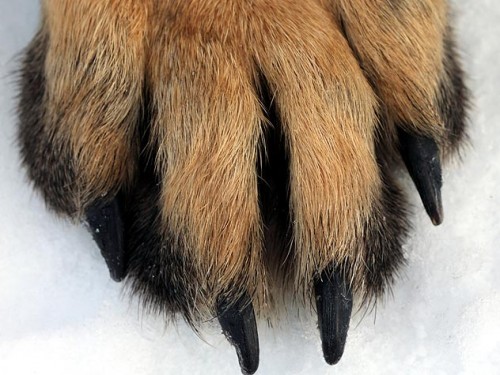7 Must-Have Tips for a Dog-Friendly BBQ
National Grilling Month kicks off on July 1, and odds are you’re making plans to host some cookouts. But before your next party, make sure you are giving extra consideration to your four-legged friend.
“It’s easy for dogs to quickly access food and other items that could be dangerous to them,” says Kiko Bracker, D.V.M., director of emergency and critical care at Angell Animal Medical Center in Boston. For instance, Bracker recalls a dog who needed emergency surgery after he ingested enough gravel to fill his stomach. Gravel alone may not be appealing, but drippings from the grill had splashed onto the rocks, tempting the dog. The hospital also receives numerous cases every summer of dogs who consume corncob holders and barbecue skewers.

1. Consider your Menu.
Because skewers pose a threat, Bracker recommends not using them. Be aware, too, that bones and corncobs can be life-threatening. “If they’re not digested, they can pass through to the small intestines, resulting in small bowel obstruction, which can become fatal without emergency veterinary care,” he says. If you do serve these items, place corncobs and bones in a garbage can that’s out of a dog’s reach. Peach pits, foil, plastic wrap, and cotton string used to bind roasts can also cause issues, so keep them away from your dog. If you want to treat your dog to a piece of meat, make sure it doesn’t contain bones and isn’t so hot that it burns your dog’s mouth.
2. Dog-Friendly Foods.
There are plenty of dog-friendly fruits and vegetables your dog can enjoy right along with you. Make sure you prepare them in a manner that is safe for your dog and make sure to feed in moderation.
3. Hot Off the Grill.
Although most dogs are smart enough to avoid an open fire, they can still get into issues with the grill, especially if it falls over and injures them, Bracker says. Their leashes, for example, may get tangled in a grill’s legs, knocking it over. Be aware that this could happen and take steps to prevent it, by securing the grill, limiting your dog’s access to it, and removing leashes or other items that might become entangled in the grill.
4. Scan the Perimeter.
In your own home, you have probably already done this, but if you are going somewhere new or heading to a park for a BBQ, check that poisonous or harmful plants and gardening supplies are out of your dog’s reach, including fertilizer, rat poison, and plant food.
5. Heat Check.
Because dogs can’t cool down as quickly as people, heat can be problematic. The rule of thumb? “When it’s too hot for us, it’s too hot for our dogs,” Bracker says. If it’s safe for your dog to be outside, provide fresh water and shelter in the shade. Otherwise, keep your dog inside and allow access to an air-conditioned room.
6. Set Some Ground Rules.
Finally, if you’re at home ask your guests to help keep your dog safe. If your dog is inside your home, remind guests to close doors behind them or watch that your dog doesn’t escape when opening yard gates.
7. Have fun!
Break out the ball or throw a Frisbee and have a doggone great time!
Caring for Your Pup’s Paws in the Winter
Winter can be a tough time for a dog’s paws. Prevent weather-related paw pad injuries by following some basic tips and the use of products designed for paw protection.
Preventing Paw Pad Injuries

Another threat from deicers is ingestion. Dogs may lick their paws or your boots and ingest deicing salts. To prevent your dog from ingesting deicing salts, keep a shallow bowl of warm water and a cloth near the entryway to your home so that you can wipe your boots and your dog’s paws when coming back inside.
Another common cause of sore paws during the cold winter months are the ice balls which form between the pads and toes of hairy-footed dog. To reduce the risk of ice balls, keep inter-pad hair trimmed neatly and short during the winter months. Not only can hairy feet contribute to the development of ice balls on the feet, paw hair can retain a lot of those nasty deicing salts. If your dog has hairy feet, trim them throughout the winter.
Dogs left in the cold for long periods of times are also at risk for frostbite on paws and hypothermia. It is not advised that dogs spend hours in the cold. In winter, frequent short walks are better for your dog than a single long walk
Bag Balm, a product available at nearly every pharmacy, applied in a thin layer daily or every other day should help keep your dog’s paws from cracking and bleeding. Keeping a humidifier in the house should also prevent dry, itchy skin for both you and your pet.
Products For Protecting Dog Paws
There are many products designed to protect dog paw pads during the winter month, from pet safe deicing products to protective waxes and dog booties. Safe Paw is a common pet-friendly deicer, but sand, small stones, and kitty litter (non-clumping) are also options for deicing while protecting your dog’s pads from injury and chemical burns. Musher’s Secret is one of the most popular paw waxes. Paw wax is applied to the pads of the feet before a walk, forming a protective barrier between the paw and the salty sidewalk or pavement. Paw wax will wear away after extended exercise, and should be reapplied before each walk.
The best protection for your dog’s paws and pads are dog booties. Just as wearing boots in the winter protects your pads, dog booties will prevent injury to your dog’s feet. Dog boots can protect your dog’s paws from salt, ice balls, and cutting his pads on sharp items that may be hidden under the snow or sharp ice. Proper sizing of dog booties is especially important in ensuring that the booties are comfortable for your dog to wear and maximize paw protection.
Dog booties may look silly, but really are the ultimate protection for your dog. Human snowsuits look silly also, but are they not the best for keeping sledding kids warm? Just as your kid may not want to wear a snowsuit, your dog may not initially like wearing booties. With a little time and patience, you can train your dog to love wearing his dog boots!
Dog Breeds Prone to Lenticular Sclerosis
Eye Problems
Two common canine eye problems are lenticular sclerosis and senile cataracts, both of which create a haze over the lens. Lenticular (nuclear) sclerosis, a type of cataract, is a bluish film that usually develops in both lenses of middle-age or senior dogs; it does not affect vision dramatically. Senile cataracts, however, are a whitish, opaque film directly affecting a dog’s retinas and vision. Most elderly dogs eventually develop one or both types of problems.
Breeds Susceptible
According to vet and behaviorist Dr. Ron Hines, some dogs get cataracts sooner than others. Among the larger breeds are cocker spaniels, German shepherds, golden retrievers, Labrador retrievers, Afghans, Chesapeake Bay retrievers, Old Eglish sheepdogs, huskies, and springer spaniels. Smaller dogs, such as Westies, poodles and schnauzers, get cataracts more frequently than other breeds. However, most dogs eventually get cataracts, especially the lenticular sclerosis type, as they age, starting at about age 6.
Other Causes
Although the cause is unknown, some dog breeds have inherited predisposition to cataract development, including lenticular sclerosis, at birth. According to Dr. Hines, typical breeds include fox terriers, bichon frises, cocker spaniels, Afghans, Boston terriers, standard poodles, miniature schnauzers, Westies and malamutes. Other contributing factors are eye injuries, eye inflammation, bad nutrition due to deficiencies in certain vitamins and minerals, and diabetes due to uncontrolled high blood sugar.
Treatment
Although you may think a dog with lenticular sclerosis is suffering, he’s not. No treatment is necessary. Most dogs adapt well to the condition and lead normal lives, with fairly good vision. However, you should have a veterinarian examine your dog and then have the vet periodically monitor for development of senile cataracts, which can, but may not, develop later. If your dog does develop full-fledged cataracts, they can be surgically corrected.





